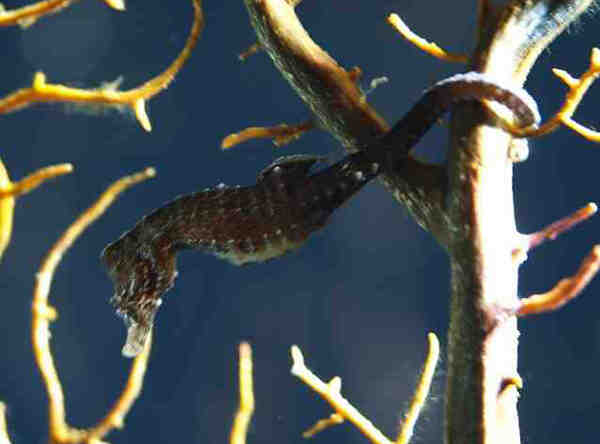Japanese Seahorse is called Japanese Seahorse in English. It is an animal of the Syngnathidae family and the genus Hippocampus.

The Japanese seahorse is a warm-temperate fish that prefers to live in coastal areas with gravel bottoms. It is commonly found in seaweed patches from mid-tide to low-tide along the coast and in inner bays, swimming slowly upright with its tail entangled in the algae. They often swim vertically by flapping their dorsal fins, with their tails swinging slowly. When they touch seaweed and other attachments, they will wrap around them and stop swimming in the water; or two seahorses' tails will wrap around each other and float in the water. They grow slowly. The suitable temperature range is 5-36℃, and the optimum is 25-29℃. The suitable salt range is 4-38‰, and the optimum is 10-30‰. They mainly feed on live baits such as copepods, amphipods, cladocerans, and shrimps.
The Japanese seahorse matures sexually in 4-10 months. They are ovoviviparous. They reach sexual maturity in 3-8 months under breeding conditions, and produce about 10-400 offspring per litter. The absolute egg production of a Japanese seahorse with a body length of less than 90 mm is 92-475, and the absolute egg production of a Japanese seahorse with a total length of 110 mm is 775. They can reproduce many times a year. The reproductive period in the South China Sea is from April to November, with the peak period from June to September, and from May to July in the Yellow Sea and Bohai Sea, during which the water temperature is 20 to 28℃. The life span is short, 2 to 3 years.
The dried whole body of Japanese seahorse is used as medicine, and is called seahorse. In summer and autumn, when catching fish and shrimp, pick out the seahorse, wash it, remove the internal organs, and remove the external dark brown membrane. The tail is curled and dried, and tied in pairs according to size. When used as medicine, it is often made with wine. Soak the seahorse in yellow wine, and bake it over a low fire until it is crisp and yellow. It tastes sweet, salty, and warm. It enters the liver and kidney meridians. It has the effects of warming the kidney, strengthening yang, dispersing knots and reducing swelling. It is mainly used to treat impotence, enuresis, asthma caused by kidney deficiency, and traumatic injuries. It is also used to treat carbuncles and boils.
The protein content of Japanese seahorse is 67.9-73.56%. Its hydrolyzed amino acid content is relatively high, with a total of 59.85-65.82%. Among the 17 amino acids contained, 7 are essential amino acids for the human body, accounting for about 30% of the total amino acids. The fatty acids docosahexaenoic acid (DHA) and eicosapentaenoic acid (EPA) in fat account for 14.1% in total.
Japanese seahorse is a precious medicinal fish, known as southern ginseng in China. It is a target of marine fishing, but there is no special fishing tool. It is a product of shrimp trawling. Since the successful trial breeding in Guangdong, China in 1957, Japanese seahorse has become a breeding target, and it is cultivated from south to north in China.
To date, there have been no underwater surveys or population estimates specifically for the Japanese seahorse (2016). Trade surveys of the Japanese seahorse conducted in 2000 showed a significant population decline of 30-68% across its range (Giles et al. 2006, Perry et al. 2010). In Cambodia, fishermen reported a drop in catches from 30 per month in 2010 to 5-10 per month in 2014, a 88% decline if extrapolated over 10 years (Aylesworth et al. 2016). The reported data demonstrate that the Japanese seahorse population is still declining and that human destruction of its habitat has not stopped and may be accelerating.
Listed in the IUCN Red List of Threatened Species (IUCN 2016 ver 3.1) - Vulnerable (VU).
Listed in the Washington Convention (CITES) - Appendix II.
Protect wild animals and eliminate game.
Maintaining ecological balance is everyone's responsibility!